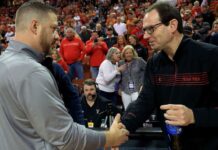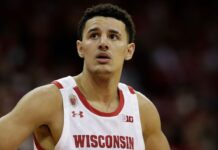Lower than 1 / 4 of the nation’s wealthiest faculty sports activities divisions say they’ve a plan to extend the quantity they may give to athletes this yr by providing money rewards for good grades.
For a lot of athletes, the college yr has been a revolutionary yr for his or her financial institution accounts. Sponsors and types have spent tens of millions of {dollars} within the newly shaped marketplace for athlete endorsement offers. And whereas faculties have rapidly invested in serving to athletes discover methods to promote their names, photos, and likeness to outdoors bidders, they’ve usually been gradual to get into their very own portfolios to benefit from a brand new, less-known rule that enables the athletics division to instantly reward athletes for robust efficiency within the class.
In response to a federal decide’s mandate, the NCAA modified its guidelines in August 2020 to permit faculties to pay as much as $5,980 to every of their athletes yearly as an instructional efficiency bonus. The given greenback quantity was calculated oddly throughout authorized proceedings as a result of it equaled the utmost financial worth an athlete might obtain in a single yr from awards associated to his athletic efficiency, equivalent to Convention Participant of the 12 months titles or the Heisman Cup. The US Supreme Court docket upheld a federal decide’s ruling 9-0 in NCAA v. Alston final June.
Based on data ESPN has collected previously a number of months from public information requests and a voluntary survey, solely 21 of 130 FBS-level faculties mentioned they’ve plans to supply these educational reward funds to athletes this yr. Twenty months after the preliminary rule change, and 9 months after eradicating any doubt about its authorized permanence, greater than a 3rd of FBS respondents mentioned they’d not but determined whether or not to supply these further advantages to athletes.
Colleges should not required to supply any new advantages or money rewards, however they do have the choice to take action. Of the 130 faculties contacted, 101 offered responses. Among the many outcomes:
• Twenty-one faculties mentioned they’d plans to reward athletes with funds for getting good grades this semester.
• 34 of them mentioned they’d not but determined whether or not or once they would begin paying educational awards.
• 21 individuals mentioned that they won’t present bonuses this yr, however plan to pay them sooner or later.
• Fifteen mentioned they don’t plan to pay educational awards.
Ten responded to public information requests by saying that they’d no paperwork related to a plan to take part, or by submitting paperwork that didn’t reveal any details about an present plan to make educational award funds.
The outcomes present one other instance of the monetary disparity between faculties throughout the pot division. 9 of the 21 faculties with plans to pay bonuses this yr are competing within the nation’s richest convention, the SEC. Georgia, the reigning nationwide soccer champion, is the one SEC college to say it stays hesitant about bonus funds.
“We wish to do the whole lot we will for our student-athletes,” mentioned Hilary Cox, affiliate athletic director of South Carolina, which introduced its bounty fee plans earlier this yr. “I do not suppose it was a tough resolution. It is some huge cash, but it surely was one thing our sporting director and administration thought was necessary.”
5 faculties within the Large 12 mentioned they’ll pay bonuses this yr. ACC has three award-paying faculties this yr, and Pac-12 has two. Wisconsin is the one Large Ten college that has mentioned it would pay bonuses this yr, but it surely additionally mentioned it’s nonetheless wanting into the finer particulars. 5 different of the highest 10 faculties mentioned they might pay athletes, however not this yr.
COVID-19 challenges might have performed a job in a slower-than-expected response to those rule adjustments, in response to lawyer Jeffrey Kessler, who represented the plaintiffs within the Supreme Court docket case final summer season. He mentioned he was glad to see a normal pattern in the direction of athletes getting extra.
“The aggressive market will emerge and we count on everybody to have these within the close to future,” Kessler mentioned. “Had it not been for COVID, I believe it will have occurred extra rapidly. … Mixed with instructional help and the NIL, it is arduous to not see that the well-being of in the present day’s athletes has considerably superior to what it was earlier than the Alston resolution.”
All however one of many faculties paying academy bonuses are coming from the Energy 5 convention. UConn, a member of the Large East, mentioned it would pay bonuses to the boys’s and ladies’s basketball gamers who earn them this yr and hopes to incorporate different sports activities sooner or later. Six different faculties from non-Authority 5 conferences say they plan to pay bonuses to their athletes sooner or later.
Terry Mohajer, athletic director at UCF, whose administration plans to begin paying educational bonuses later this summer season, mentioned he wasn’t significantly involved concerning the hole between Energy 5 faculties and others. Mohajer mentioned that bonuses paid could make all of the distinction in offering peace of thoughts for a lot of athletes (particularly these on partial scholarships), however most athletes will not select faculties primarily based on the potential of getting just a few thousand additional {dollars} per semester, so that they have not He doesn’t suppose it would exacerbate any aggressive imbalance.
Mohajer mentioned discovering cash to make the funds was the principle problem to be resolved earlier than the UCF might go forward with paying the athletes.
“We now have to funds for it,” Mohajer mentioned. “It is actually only a funds line merchandise, which is why we plan to do this within the coming interval.”
Budgets for fringe advantages ranged from just a few hundred thousand {dollars} to $6 million, in response to survey responses. Most faculties estimate that they might want to preserve anyplace from $2 million to $3 million yearly to pay bonuses to athletes.
Many sports activities departments set their budgets in late spring, and sure determined methods to allocate funds for the present college yr earlier than a Supreme Court docket ruling final summer season solidified these new guidelines.
Nevertheless, many colleges have demonstrated the power to increase or regulate their mid-year funds spending when coaching adjustments are wanted. Virginia Tech, for instance, this winter agreed to pay greater than $8 million to purchase the contract of former soccer coach Justin Fuente, but it surely hasn’t finalized a plan for the way it will present an incentive for its athletes to get good grades. Michigan negotiated a $3 million increase for soccer coach Jim Harbaugh in 2023 after he led the Wolverines to the school soccer recreation, however has but to resolve whether or not to make use of a few of its nine-figure funds to pay educational bonuses.
Each Michigan and Virginia Tech declined interview requests. Virginia Tech initially responded to the ESPN survey by saying that it had not but decided on whether or not or to not provide bonus funds. When the speaker was requested to present an interview, he made an announcement saying the college was working by detailing how a lot cash every athlete ought to obtain and what the rewards incomes thresholds ought to be. He mentioned the college plans to begin a program within the fall.
The shortage of urgency from many colleges creates a scenario the place coaches or directors might obtain a whole lot of 1000’s of {dollars} in reward for his or her gamers’ efficiency at school, whereas the gamers themselves obtain no further fee. Cal soccer coach, Justin Wilcox, for instance, signed a contract extension this winter, which might make him eligible to obtain as much as $210,000 if his gamers rating excessive within the class this yr. Gamers themselves is not going to be eligible to earn any cash for a similar scores on this semester.
Cal initially responded to the ESPN ballot by saying he hadn’t decided about providing bonuses to athletes. When requested for an interview — a request that was denied — a spokesperson for the Athletics Division mentioned the college plans to begin providing new advantages within the fall.
Alabama soccer coach Nick Saban is eligible to obtain as much as $100,000 in reward for his gamers’ educational efficiency. The sports activities division Crimson Tide didn’t reply to a number of requests for details about its plans to pay bonuses to athletes and didn’t reply to a request for public information.
The sports activities departments that made the plans largely seen the brand new choice as a means to supply as many athletes as doable for the athletes. Most respondents with a plan mentioned that to get the complete $5,980 of their faculties, the athletes needed to obtain a mixture of remaining educational {qualifications} to compete underneath NCAA guidelines and have a clear disciplinary document.
Some faculties have chosen to have larger obstacles for athletes to get cash. In Missouri, athletes will obtain $2,400 to achieve educational eligibility however want a GPA of three.5 or larger to obtain the complete award. Iowa plans to maintain all of the bonus cash that athletes accumulate all through their faculty life and pay it as a lump sum provided that and once they graduate.
The colleges have additionally taken completely different approaches to the athletes who will probably be eligible for bonus funds. Some faculties will provide bonus funds to any participant on any of their rosters, whereas others plan to supply bonuses solely to novice athletes. A gaggle of 5 faculties equivalent to UConn and UCF mentioned they plan to begin by providing rewards to athletes who play the sports activities that generate essentially the most income, and increase from there.
Not like all different types of compensation that faculties will pay athletes, these awards selections should not made on the union degree. Some conferences have offered requirements and pointers for his or her faculties. For instance, the Large 12 determined that solely scholarship athletes on the convention can be eligible for bonuses, which hasn’t occurred at another conferences. To a big extent, although, the faculties had been on their very own to determine how they needed to navigate this new choice as a result of any settlement or dialogue on the affiliation degree about what was affordable can be thought-about a violation of the antitrust legal guidelines mentioned within the Alston case.
“That is the attention-grabbing factor about it,” mentioned Cox of South Carolina. “This is likely one of the first instances we aren’t collectively talking [as an association] about what we do. For us, we actually needed to place the pedal to the steel and say, “Let’s do that.”
Kessler mentioned faculties are actually compelled to make selections like all different unbiased companies within the nation “versus working as a member of a cartel.” He mentioned faculties have had no downside making unbiased selections about methods to spend their cash on employees coaching or bettering amenities, and he is assured that over time the aggressive forces of the market will make them discover room within the funds to push these further advantages to athletes as properly.



